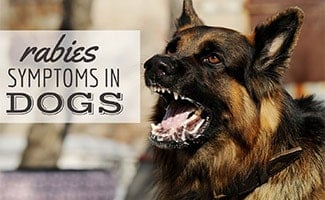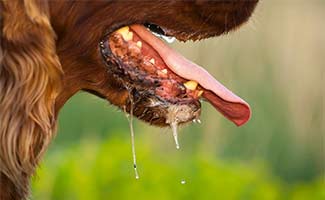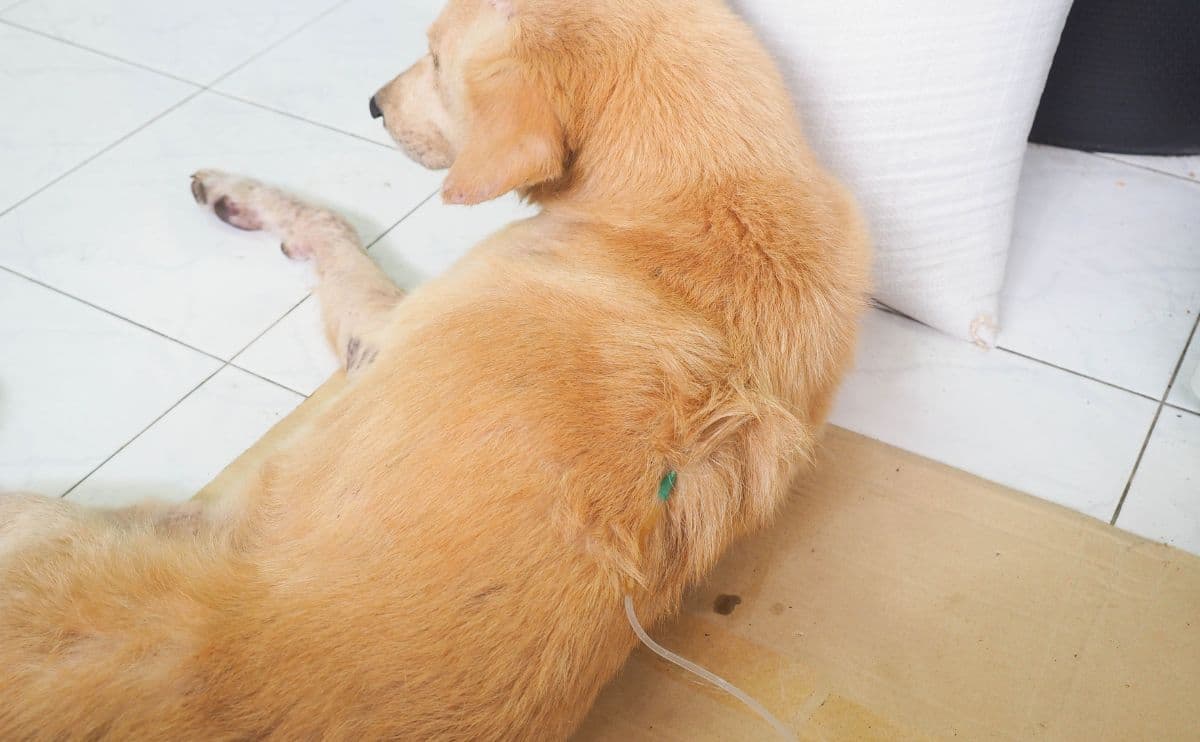This content was reviewed by veterinarian Dr. Katherine Baldwin, DVM.
When you purchase through links on our site, we may earn a commission. Here’s how it works.

When most of us think about rabies, we picture an animal foaming at the mouth and acting aggressive or erratic. But there are many other signs of rabies in dogs. Learn more about rabies symptoms in dogs, what to do if your dog gets bitten by an infected animal, and how you can easily prevent this devastating disease.
What Is Rabies?
Rabies is a virus that infects the central nervous system, causing disease in the brain and spinal cord. It can affect dogs, cats, humans, and any other mammal.
Rabies is an incurable virus, however, it can be treatable if caught early on. Seeking immediate veterinary attention if you suspect your dog has been exposed to the rabies virus is essential. Unfortunately, once the symptoms of rabies appear, the virus is fatal.
The rabies virus attacks the nervous system of the dog. Initially, after infection, dogs may be asymptomatic and then progress to two main forms of the disease: the furious form and the paralytic form. It’s possible to display signs of one or both forms. Ultimately, death is caused by progressive paralysis throughout the body in both forms.
Paralytic Rabies
Paralytic rabies, also referred to as “dumb rabies,” is the more common type in dogs. Dogs suffering from paralytic rabies experience weakness, loss of coordination, and eventually paralysis. Paralysis often starts at the throat and jaw muscles leading to excessive salivation and difficulty swallowing. Drooping of the lower jaw can be seen. Animals with the paralytic form of rabies may not be vicious and rarely attempt to bite.
Furious Rabies
The furious form of rabies is the classic “mad-dog” syndrome, although it is seen in other species as well as dogs. Behavioral changes are often extreme and sudden. Animals can lose the fear of people and other animals and may bite or attack without being provoked. As the virus progresses, dogs may experience seizures or lack of coordination.
How Do Dogs Get Rabies?
Rabies is secreted through saliva and can pass to canines through a bite from an infected animal. Dogs can also become infected if they have a scratch or open wound that’s exposed to contaminated saliva. While it can pass between pets, rabies in dogs most frequently comes from exposure to wild animals like bats, raccoons, and foxes
If you believe your dog has come into contact with a rabid animal, you should take her to the veterinarian immediately. The early stages of rabies can appear similar to a lot of other diseases.
What’s The Incubation Period?
The incubation period (the time from initial exposure until signs of rabies appear) can vary from 10 days to one year or longer. In dogs, the average incubation period is usually two weeks to four months. Some factors affect this period, including:
- The severity of the bite – with severe bites, more of the virus gets secreted into a dog’s system
- The site of infection – the closer the bite is to the brain or spinal cord, the quicker the virus travels to the nervous tissue
Rabies Symptoms In Dogs
Unfortunately, there’s no way to treat rabies in dogs once symptoms appear, and it’s almost always fatal. Below are the signs to look for.
First-Stage Symptoms

This first stage of rabies, called the prodromal phase, typically lasts one to three days before symptoms worsen. However, the progression of rabies is very variable, and some cases progress rapidly causing muscle paralysis and death within hours of the symptoms first appearing. The most obvious initial sign is a sudden change in behavior and temperament. For example, quiet or shy dogs can become aggressive, and friendly, outgoing dogs can become nervous or shy. Signs in this stage can include:
- Shyness or aggression
- Anxiety
- Lethargy
- Fever
- Vomiting
- Decreased appetite
- Changes in bark
Second-Stage Symptoms

After just a few days, symptoms quickly progress to one or a combination of both forms of rabies. Here are the signs for each type.
Signs Of Paralytic Rabies
- Progressive paralysis
- Uncoordinated
- Dropped jaw
- Facial distortion
- Excessive salivation
- Difficulty swallowing
- Foaming of the mouth
- Difficulty breathing
- Seizures
Signs Of Furious Rabies

- Extreme excitability
- Aggression toward people, other animals, and inanimate objects
- Hypersensitivity to light and sound
- Pica (appetite for non-nutritious substances)
- Paralysis
- Inability to eat or drink
- Seizures
If you’re concerned your dog has rabies, it’s important to protect your health and the health of those around you. Do not approach animals that are displaying symptoms to avoid bite wounds and transmission of the virus. And take care to avoid direct contact with the saliva of dogs with rabies infection. Always keep your distance, warn others nearby if you suspect a dog has rabies, and alert the authorities.
Signs Of Rabies In Dogs Infographic

Diagnosis & Treatment
A definitive diagnosis of rabies can be challenging and requires a tissue sample from the brain or nerves to confirm a diagnosis. These samples can only be taken after death at the time of post-mortem. However, post-exposure treatment is very effective at preventing the virus from progressing.
If you’re concerned your dog has been exposed to rabies, a veterinarian will help assess what treatment is appropriate for your dog. Treatment may include flushing (or ‘lavaging’) any wounds that are present and administering additional rabies vaccination to improve your dog’s immune response to the virus.
What Does A Dog With Rabies Look Like? (Video)
Warning: this video shows a dog with rabies in the later stage, which can be hard to watch.
Control Of Rabies
The World Health Organization (WHO) has strict guidelines to control rabies in the dog population and ongoing projects to reduce the incidence of this devastating virus worldwide. They achieve this through:
- Notification of suspected cases and euthanasia of dogs with clinical symptoms of the virus and dogs known to be bitten by a rabid animal.
- Laws around quarantine and walking dogs on leashes in some countries to reduce contact between susceptible dogs and wild animals.
- Mass vaccination program and continual booster vaccinations to maintain immunity.
- Stray dog control to reduce populations of dogs that could be exposed to the virus and spread it to other dogs, animals, or people.
Rabies Vaccine For Dogs
The rabies vaccine will help prevent your dog from getting the virus, and it’s legally required in most U.S. states. Puppies must be vaccinated initially at three months of age in most states. After this initial vaccine, booster shots are required, but the frequency varies by state. Some states require the booster vaccine to be given yearly while others require it every three years. Be sure to check your state’s laws so you know the requirements for your canine. It’s crucial to keep your dog up-to-date with the rabies vaccine and all other necessary vaccinations.
Tagged With: Infectious Disease, Reviewed By Dr. Katherine Baldwin, Vaccinations


